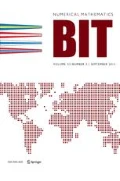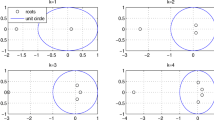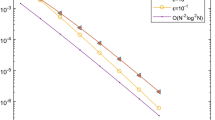Abstract
A class of block boundary value methods (BBVMs) is constructed for linear weakly singular Volterra integro-differential equations (VIDEs). The convergence and stability of these methods is analysed. It is shown that optimal convergence rates can be obtained by using special graded meshes. Numerical examples are given to illustrate the sharpness of our theoretical results and the computational effectiveness of the methods. Moreover, a numerical comparison with piecewise polynomial collocation methods for VIDEs is given, which shows that the BBVMs are comparable in numerical precision.
Similar content being viewed by others
References
Brugnano, L.: Essentially symplectic boundary value methods for linear Hamiltonian systems. J. Comput. Math. 15(3), 233–252 (1997)
Brugnano, L., Trigiante, D.: High-order multistep methods for boundary value problems. Appl. Numer. Math. 18(1–3), 79–94 (1995)
Brugnano, L., Trigiante, D.: Convergence and stability of boundary value methods for ordinary differential equations. J. Comput. Appl. Math. 66(1–2), 97–109 (1996)
Brugnano, L., Trigiante, D.: Block boundary value methods for linear Hamiltonian systems. Appl. Math. Comput. 81(1), 49–68 (1997)
Brugnano, L., Trigiante, D.: Boundary value methods: the third way between linear multistep and Runge-Kutta methods. Comput. Math. Appl. 36(10–12), 269–284 (1998)
Brugnano, L., Trigiante, D.: Solving Differential Problems by Multistep Initial and Boundary Value Methods, volume 6 of Stability and Control: Theory, Methods and Applications. Gordon and Breach Science Publishers, Amsterdam (1998)
Brunner, H., Pedas, A., Vainikko, G.: A spline collocation method for linear Volterra integro-differential equations with weakly singular kernels. BIT 41(5, suppl.), 891–900 (2001). BIT 40th Anniversary Meeting
Brunner, H.: Nonpolynomial spline collocation for Volterra equations with weakly singular kernels. SIAM J. Numer. Anal. 20(6), 1106–1119 (1983)
Brunner, H.: Polynomial spline collocation methods for Volterra integrodifferential equations with weakly singular kernels. IMA J. Numer. Anal. 6(2), 221–239 (1986)
Brunner, H.: Collocation methods for Volterra integral and related functional differential equations, volume 15 of Cambridge Monographs on Applied and Computational Mathematics. Cambridge University Press, Cambridge (2004)
Brunner, H., Pedas, A., Vainikko, G.: Piecewise polynomial collocation methods for linear Volterra integro-differential equations with weakly singular kernels. SIAM J. Numer. Anal. 39(3), 957–982 (2001)
Chen, H., Zhang, C.: Boundary value methods for Volterra integral and integro-differential equations. Appl. Math. Comput. 218(6), 2619–2630 (2011)
Chen, H., Zhang, C.: Block boundary value methods for solving Volterra integral and integro-differential equations. J. Comput. Appl. Math. 236(11), 2822–2837 (2012)
Chen, H., Zhang, C.: Convergence and stability of extended block boundary value methods for Volterra delay integro-differential equations. Appl. Numer. Math. 62(2), 141–154 (2012)
Diethelm, K., Garrappa, R., Stynes, M.: Good (and not so good) practices in computational methods for fractional calculus. Mathematics 8(324), (2020)
Ghiat, M., Guebbai, H.: Analytical and numerical study for an integro-differential nonlinear Volterra equation with weakly singular kernel. Comput. Appl. Math. 37(4), 4661–4674 (2018)
Iavernaro, F., Mazzia, F.: Block-boundary value methods for the solution of ordinary differential equations. SIAM J. Sci. Comput. 21(1), 323–339 (1999)
Kangro, R., Parts, I.: Superconvergence in the maximum norm of a class of piecewise polynomial collocation methods for solving linear weakly singular Volterra integro-differential equations. J. Integ. Equ. Appl. 15(4), 403–427 (2003)
Parts, I.: Optimality of theoretical error estimates for spline collocation methods for linear weakly singular Volterra integro-differential equations. Proc. Estonian Acad. Sci. Phys. Math. 54(3), 162–180 (2005)
Tang, T.: A note on collocation methods for Volterra integro-differential equations with weakly singular kernels. IMA J. Numer. Anal. 13(1), 93–99 (1993)
Vainikko, G.: Multidimensional Weakly Singular Integral Equations. Lecture Notes in Math. 1549. Springer, Berlin, Heidelberg, New York (1993)
Xu, X., Xu, D.: A semi-discrete scheme for solving fourth-order partial integro-differential equation with a weakly singular kernel using Legendre wavelets method. Comput. Appl. Math. 37(4), 4145–4168 (2018)
Zhou, Y., Zhang, C.: Convergence and stability of block boundary value methods applied to nonlinear fractional differential equations with Caputo derivatives. Appl. Numer. Math. 135, 367–380 (2019)
Author information
Authors and Affiliations
Corresponding author
Additional information
Communicated by Mechthild Thalhamme.
Publisher's Note
Springer Nature remains neutral with regard to jurisdictional claims in published maps and institutional affiliations.
The work of Martin Stynes is supported in part by the National Natural Science Foundation of China under grant NSAF-U1930402.
Piecewise polynomial collocation methods
Piecewise polynomial collocation methods
We give a brief review of piecewise polynomial collocation methods in this appendix. Introducing a new unknown function \(x=y'\), the VIDE (1.1) can be rewritten as
Using the same mesh as before, with the same notation, we write \(x_{n,i}\) for the computed approximation of \(x(t_{n,i})\) for \(0 \le i \le m\) and \(1\le n \le N\). This is defined by
In the above formulas,
From the above equation, for each \(n\ge 1\) one can obtain the unknown vector \(X_n = \left( x_{n,1}^T,x_{n,2}^T,\ldots ,x_{n,m}^T\right) ^T\). Then the approximation y is computed iteratively by
Rights and permissions
About this article
Cite this article
Zhou, Y., Stynes, M. Block boundary value methods for linear weakly singular Volterra integro-differential equations. Bit Numer Math 61, 691–720 (2021). https://doi.org/10.1007/s10543-020-00840-1
Received:
Accepted:
Published:
Issue Date:
DOI: https://doi.org/10.1007/s10543-020-00840-1
Keywords
- Block boundary value methods
- Linear weakly singular Volterra integro-differential equation
- Graded mesh
- Convergence
- Stability




